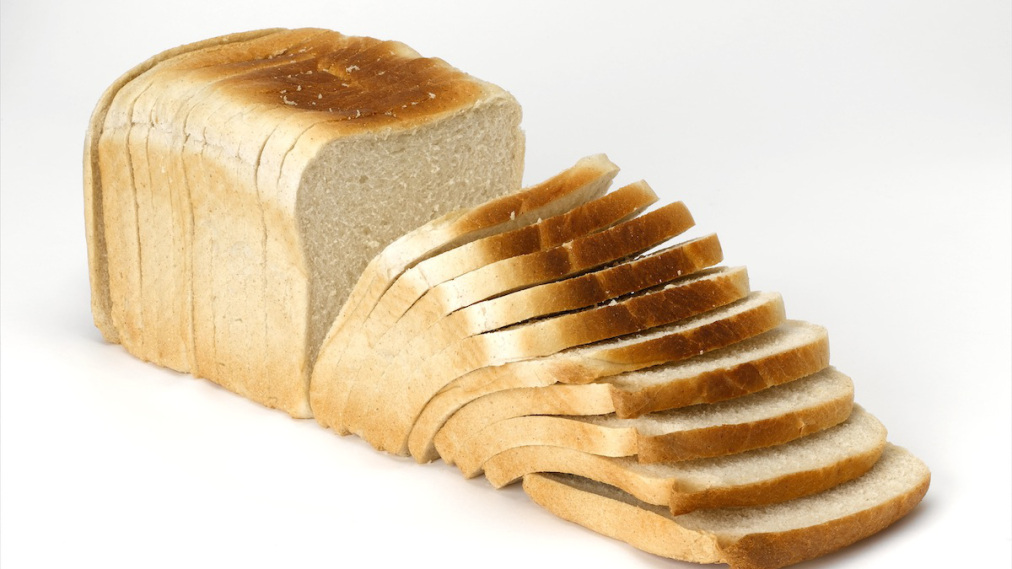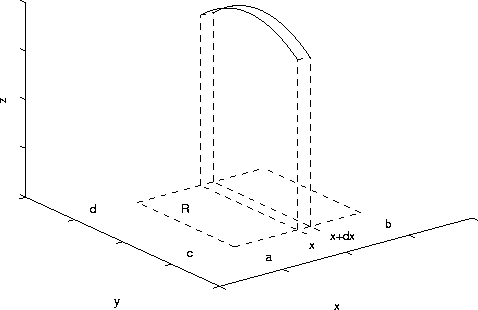- No more quizzes!
- Your homework 4.5 is returned: graded 7, 20, 39
- Homework 5.1 due today.
- Homework 5.2 is due on Thursday.
- Today we're going to look at some other examples of
applications of integration, then on Thursday we'll review. How
quickly does a semester come to an end....
- I've got a bunch of old sections of mat129, and you can look for
old finals:
- http://ceadserv1.nku.edu/longa//classes/2010spring/mat129/tests/final/final.pdf
- http://ceadserv1.nku.edu/longa//classes/2011spring/mat129/tests/final/final.pdf
- http://ceadserv1.nku.edu/longa//classes/2012fall/mat129/tests/final/final.pdf
- http://ceadserv1.nku.edu/longa//classes/2013spring/mat129/tests/final/final.pdf
- http://ceadserv1.nku.edu/longa//classes/2016spring/mat129/tests/final/final.pdf
-
Let's see how to compute volumes of some "simple" (okay,
relatively simple!) objects using integrals.
Before you may have memorized some of these formulas. Now you can derive them! The power of calculus....
In every case for what follows, we begin with what I consider the most important formula for integral calculus (which in this case we write using the letter $V$, for volume):
\[ V=\int{dV} \]
Of course this is also how you would compute integrals of wine ("Vino", adding up little chunks of vino), or even Vemicelli: \[ Vino=\int{dVino} \] or \[ Vermicelli=\int{dVermicelli} \]
To calculate any quantity $V$, we simply divide it up into infinitesimal quantities $dV$, and add an infinity of them up.
Now to calculate volumes we'd better know the extent of the object of interest, so we'll march along the $x$-axis from $a$ to $b$, stop at $x$, and add in the little $dV$ that is found there. So in each case what we need to do is find $dV$ (which, by the way, is a function of some other variable, usually -- in the following it's a function of $x$):
\[ V=\int_{a}^{b}dV(x) \]
Often (certainly in this section) our next step is to write $dV(x)$ as an area, which is a function of $x$, times dx:
\[ V=\int_{a}^{b}dV(x)=\int_{a}^{b}A(x)dx \]
This is the "sliced bread" problem: the volume of a loaf of bread is the sum of the volumes of the slices, which have thickness $\Delta x$ (they're not infinitesimal, because they wouldn't be very filling if they were), and cross sectional area $A(x)$, which varies along the loaf -- like sometimes there's that skinny little heel at the end, with a small $\Delta x$ and a little cross-sectional area).

So our problem becomes to find $A(x)$ -- what are the cross-sectional areas?

Let's take a look at some examples:
- The cube of side length $s$:
\[ dV(x)=A(x)dx=s^2dx \]
\[ V=\int_{0}^{s}dV(x)=\int_{0}^{s}s^2dx \]
- The right circular cylinder of radius $r$ and
height $h$
\[ dV(x)=A(x)dx=\pi{r}^2dx \]
\[ V=\int_{0}^{h}dV(x)=\int_{0}^{h}\pi{r}^2dx \]
- The cone of radius $r$ and height $h$:
\[ dV(x)=A(x)dx=\pi\left(r(1-\frac{x}{h})\right)^2dx=\pi{r^2}(1-\frac{2x}{h}+\frac{x^2}{h^2})dx \]
\[ V=\int_{0}^{h}dV(x)=\int_{0}^{h}\pi{r^2}(1-\frac{2x}{h}+\frac{x^2}{h^2})dx \]
- The pyramid of height $h$, and base $s$:
This is Example 8, p. 359.
- The sphere of radius $r$:
\[ dV(x)=A(x)dx=\pi\left(\sqrt{r^2-x^2}\right)^2dx=\pi(r^2-x^2)dx \]
\[ V=2\int_{0}^{r}dV(x)=2\int_{0}^{r}\pi(r^2-x^2)dx \]
(the "2" is out in front because we're using symmetry: we calculate the volume of half the sphere in running from 0 to $r$, then double it).
- The cube of side length $s$:
- Surfaces "of revolution" (revolutionary surfaces?) are a
special class, and actually a little easier to work with -- because of
symmetry. You get cross-sectional areas that are either disks or
annuli (rings), so they're defined once you know their radii as
a function of $x$: so in this case,
\[ V=\int_{a}^{b}dV(x)=\int_{a}^{b}A(x)dx=\int_{a}^{b}\pi r(x)^2dx \]
Let's look at example 2, p. 355.
Sometimes we "gut" a revolutionary solid with another revolutionary solid, leading to rings:
Let's look at example 4, p. 356.
\[ V=\int_{a}^{b}dV(x)=\int_{a}^{b}A(x)dx=\int_{a}^{b}\pi (r_{out}(x)^2-r_{in}(x)^2)dx \]
- Examples:
- #48, p. 361
- #4 and 5, p. 360
- #16
- #52, p. 361
Today we'll look at three different application of integrals:
- A time integral
- A work problem
- A mass problem
\[ A=\int{dA} \]
But in each case, we have a different type of quantity that we're after:
- A time integral: $T=\int{dT}$
- A work problem: $W=\int{dW}$
- A mass problem: $M=\int{dM}$
- The time to travel between exits on the interstate:
You're tooling down the road, and you look up to see an electronic sign on the highway: 7 miles, 9 minutes to State Route 126. How does one figure out that it's going to take me 9 minutes?
Well, why might travel time to State Route 126 (Exit 10A) from Exit 3 on I-75 might be represented as this integral:
\[ T = \int dT = \int_{{\textrm{Exit 3 on I-75}}}^{{\textrm{State route 126}}} \frac{dx}{v(x)} \]
where
- $x$ is the location along the freeway.
- $v(x)$ is the average automobile velocity at every point $x$ along the road from point $a$ to point $b$.
- $dT$ was calculated using the DiRT formula - don't forget the dirt formula - \[ distance=rate*time \] so \[ dx = v(x) dT \] and we solve for $dT$.
Let's look at a couple of cases:
- $v(x)=60$ (constant, 60 mph)
- $v(x)$ is given by speeds obtained from well-placed radar guns: suppose \[ \left [ \begin{array}{c|cccccccc} {x}& {0}&{1}&{2}&{3}&{4}&{5}&{6}&{7}\cr \hline {v(x)}&{60}&{50}&{30}&{45}&{60}&{55}&{60}&{70} \end{array} \right ] \]
- Let's now compute the work required to fill a spherical water tank
with water.
- The sphere is of radius 2 meters.
- The center of the sphere is 20 meters above the surface of the source of water.
- Water has a density of $\rho=1000kg/m^3$
- Work is force times displacement: $W=F*d$
-
\[ W=\int{dW}=\int{dW(y)}=\int{dF(y) y} \]
In particular, force equals mass time acceleration (ask Newton), so
\[ W=\int_{18}^{22}{(dm(y) g) y} \]
\[ W=\int_{18}^{22}{(dV(y) \rho) g y} \]
\[ W=\int_{18}^{22}{(\pi r(y)^2 dy) \rho g y} \]
Finally, we have
\[ W=\pi \rho g \int_{18}^{22}{\left(\sqrt{2^2-(y-20)^2}\right)^2 y dy} \]
\[ W=\pi \rho g \int_{18}^{22}{(2^2-(y-20)^2) y dy} \]
(units are Newton-meters, or Joules).
- What is the mass of the atmosphere?

- Need to know a little about the Earth (whose radius is 6,360 km).
- We might propose a linear model for the mass density of the atmosphere, based on the data in the graphic. Let's figure that out.... What do you think of this model: \[ \rho(x) = 10^{-3(1+x/50)} \] (Why is everything to the power 10?!).
- The surface area of a sphere: $4\pi{r^2}$
- Here's a target: let's see if we get close. NASA says: "The total mean mass of the atmosphere is $5.1480\times 10^{18}kg$...."